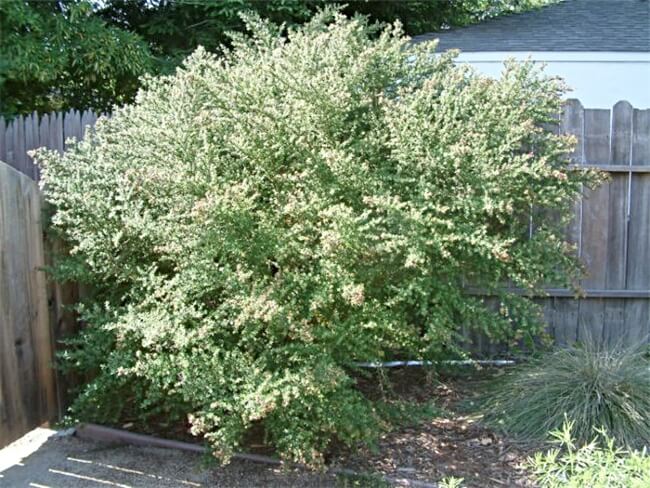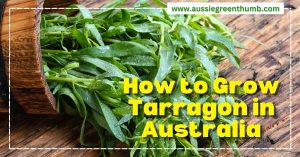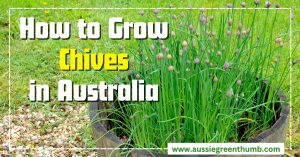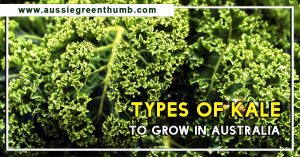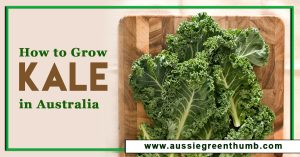One of the most useful tea trees for any small garden is Leptospermum petersonii, the lemon-scented tea tree. It is easy to grow, rewarding, and packed with summer fragrance thanks to its heavenly-scented leaves.
Like all plants in the Myrtle family, there is a risk of spreading throughout Australia, and it can germinate in a variety of conditions, so should be planted with caution in some parts of the country. But for the most part, thanks to its small stature, it rarely interacts with or disrupts the habitat of other species.
We’ve packed everything you need to know about growing lemon-scented tea trees into this guide, so you can start from seeds, or grow young trees into beautifully formed garden centrepieces.
More...
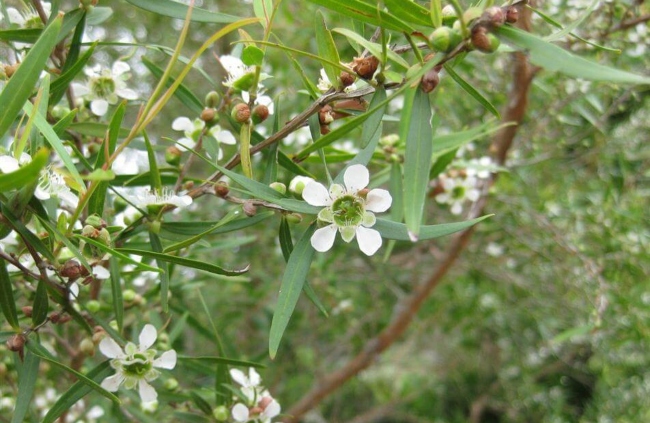
Source: Evergreen Growers
Family: | Myrtaceae |
|---|---|
Genus: | |
Species: | L. petersonii |
Common names: | Lemon-scented tea tree |
Origin: | Australian native |
Location: | Outdoor |
Type: | Small tree |
Growth: | 5m tall |
Sun requirements: | Full sun |
Foliage colour: | Green |
Flower colour: | White |
Flowering: | Summer |
Edible parts: | Leaves are used to make herbal tea |
Maintenance level: | Low |
Poisonous for pets: | Essential oil may be toxic to cats and dogs |
What is Leptospermum petersonii?
Leptospermum petersonii is a small tree in the myrtle family (Myrtaceae), with flaky bark and powerfully fragrant leaves. Its foliage is lanceolate (lance-shaped) and its flowers, while short-lived are followed by fruit that is held on the tree for up to three years (making maintenance simple, so you can simply snip seed capsules off the tree at your own pace, rather than leaving them to drop and spread.
Growing to an ultimate height of 5m tall makes them exceptionally useful for smaller gardens, where they work beautifully at a centrepiece in the middle of open lawns, or nestled in amongst other planting.
Lemon-Scented Tea Tree’s Natural Habitat
Leptospermum petersonii is native to eastern Australia, growing in wet sclerophyll forests (a contradictory term that means wet forests, with planting adapted to prolonged dry conditions).
Its main territory is the north coast of New South Wales, though it has naturalised through cultivation around Sydney and Melbourne – where it is often planted in parks, gardens, and roadside verges.
Common Uses for Leptospermum petersonii
Leptospermum petersonii is an edible tea tree, though, like all tea trees, the concentrated essential oils may be toxic to humans and animals alike when ingested.
Of all the myrtles, tea trees, Leptospermum and Eucalyptus used to brew fragrant teas from though, the lemon-scented tea tree has to be the most flavour-packed of all.
The leaves can be harvested at any time of year and dried for long-term storage or used fresh.
How to Grow Leptospermum petersonii
Leptospermum petersonii is a small tree, used commonly in gardens throughout Australia and across the world because its height allows it to be used in a variety of settings. For smaller gardens with enough upward space, it is a perfect tree to add height and make your garden feel bigger.
For balconies and terraces, Leptospermum petersonii works best when pruned into a multi-stemmed shrub, and can be topiarised loosely into more ornamental forms too.
Because of that, it works just as well in large pots as it does in the ground, but will require more specific growing conditions in containers, which we will detail in the next section.
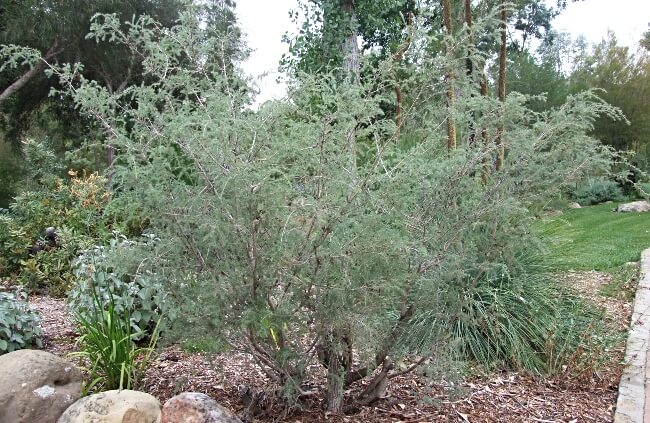
Source: PlantMaster
Best Conditions for Growing Leptospermum petersonii
Leptospermum petersonii prefers full sun, but can cope with dappled shade for part of the day, and will work well in competition with other plants. Its roots are spreading but not invasive, and it has minimal nutrient requirements, meaning it can be underplanted with reasonably tough shade-lovers (hellebores work particularly well under its canopy in winter).
Soil & Drainage
Leptospermum petersonii is well suited to most soil types but dislikes wet clay. Provided there is reasonable drainage, and it isn’t overfed, it can be planted in any reasonably well-drained spot.
Aim for a neutral mix of compost and sandy topsoil when planting into containers or raised areas, making sure the mix retains some water and has plenty of grit or crocks added to the base of the pot to aid overall drainage.
Light & Temperature
Theoretically, Leptospermum petersonii needs full sun, but it will grow in light shade, and we’ve got a south-facing spot here, with shade for nearly six hours a day, with a gorgeous lemon-scented tea tree growing perfectly well in a pot.
Planting Leptospermum petersonii
Leptospermum petersonii can be planted as individual trees or as a hedge. In both cases, plant them just slightly proud of the soil level, and water them deeply. They should not need staking unless they are very exposed.
Delay underplanting for the first year, and water them well once a fortnight through their first summer to help roots establish. In their second or third year, underplant as desired to add volume to the base of the plants, and make the most of any available soil.
Growing Lemon-Scented Tea Tree in Pots
Regardless of the eventual size you are planning for these adaptable trees, and even if you are planting them to prune as topiary or shrubs, they should be given a pot that is at least 30cm across, or 10-15cm wider than their root ball.
They will require potting on or root-pruning every three years to maintain root health, and you can add fresh compost when you do this, to gently boost nutrition, and support new roots.
When planting in pots, it is worth underplanting straight away with trailing ground-cover plants like thyme, vinca or ivy that will not deplete soil nutrients but can help to shade the soil and retain moisture during hot, dry, weather.
How to Propagate Leptospermum petersonii
There are two fairly simple ways to propagate Leptospermum petersonii, but the most common cultivation technique is to grow new plants from cuttings. Whether growing from cuttings or from seed, both are best done in mid to late spring and out of direct sunlight.
We will look at both methods in more detail below.
Propagating Leptospermum petersonii from Seeds
To grow Leptospermum petersonii from seed, collect seeds from pods held on the plant, or from a trusted seller. There is no need to prepare the seed by soaking, chilling, or scarifying.
Start seeds in spring, indoors at around 18°C, in individual pots as they prefer not to be moved or handled until the roots have developed.
Leave pots in a warm, bright spot, without exposure to midday or early afternoon sun, and they should germinate after 2-3 weeks. Grow on in a protected space (windowsills or greenhouses are ideal).
The ideal compost is coco coir or a peat-free compost, sieved and mixed with perlite or vermiculite to aid drainage and manage moisture levels.
Get expert advice on selecting and using coco coir in our comprehensive guide.
Lemon-Scented Tea Tree Propagation from Cuttings
To grow Leptospermum petersonii from cuttings, take semi-ripe stems between October and November, including a short heel. The hell is a short wick of bark and the material beneath it, including part of the node and the area below it.
Do this by cutting carefully into the stem with a sharp knife, and tearing the final few mm. Dip the cut end in rooting gel, and place it into a free-draining potting medium, before watering.
Strip any leaves other than the top set away to reduce moisture loss, and then leave it somewhere bright. Once rooted, the cuttings will grow quickly, but keep them indoors or protected from frost for their first year.
Caring for Leptospermum petersonii
Leptospermum petersonii, the lemon-scented tea tree, is pretty easy to care for, but like any shapeable tree, regular pruning will very much depend on how you want it to look. They grow to a maximum of 5m tall, and are happy in most soils, without added nutrients or mulch.
So, if you’re aiming for a tree with a standard canopy, as it will naturally produce, no ongoing care is required.
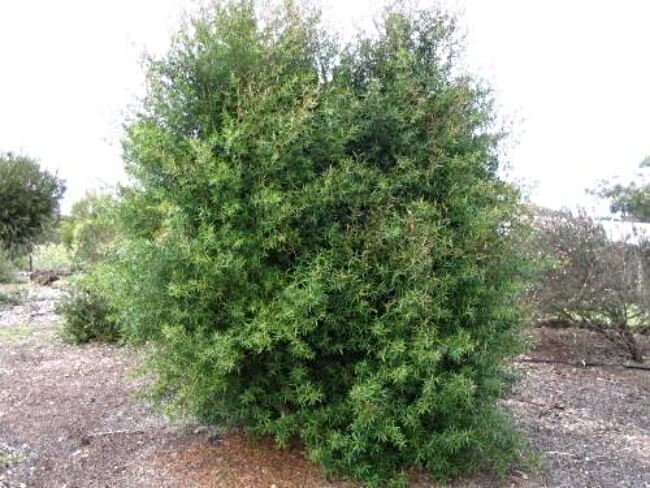
Source: Great Ocean Road Nursery
Pruning Lemon Tea Tree
If you are growing Leptospermum petersonii as a shrub, you can cut back quite hard, but avoid cutting back past foliage, unless it is to a swollen node. These can reshoot if everything above them is removed and are useful if you need to remove dead, damaged or diseased growth.
To prune Leptospermum petersonii grown as a hedge, prune once a year after flowering. This will prevent seeds from developing and dropping, and maintain the shape of your hedge for the year ahead. If any leaders emerge, prune back into the foliage to hide cuts and maintain a more natural form.
Repotting Leptospermum petersonii
Repot Leptospermum petersonii once every three years, or when the roots are circling the pot. Provide additional space if potting up, or root prune hard after shaking off loose soil and compost.
After shaking off loose compost, trim roots with clear shears by 2-3cm. It seems severe but it triggers fresh feeding roots and encourages slower, healthier, top growth. Use the opportunity to add fresh compost or topsoil to the pot.
Common Leptospermum petersonii Pests and Diseases
Leptospermum petersonii is not bomb-proof, but it is tough. Most common root fungus will not affect it, and unless it is severely waterlogged for a prolonged period, it will carry on growing quite happily.
The most common fungal diseases that affect Leptospermum petersonii are leaf-based, and nearly always occur due to pest damage.
Brown patches on leaves and orange spots can be caused by fungus, including myrtle rust, entering the leaves. Sometimes this is due to wet weather paired with cold winds, but is more common following an infestation of Myrtle-family-loving pests.
Mites, thrips and mealybugs will cause similar types of leaf damage, feeding from the underside of leaves, causing small spots that can spread into brown patches if exposed to disease.
Webbing caterpillars are problematic too, as they can defoliate the plant, and increase humidity around foliage.
All pests can be managed by native predators, but severe infestations on hedges or potted Leptospermum petersonii can be stopped in their tracks with neem oil.
Lemon Tea Tree Frequently Asked Questions
What is the common problem with Leptospermum petersonii?
The most common problem with Leptospermum petersonii is a native moth with a caterpillar known as the webbing caterpillar. Once hatched, the caterpillars mesh leaves into bundles for protection, making them hard to get at, and defoliate trees through feeding, and by stunting growth and foliage development.
Does Leptospermum petersonii need ericaceous soil?
Leptospermum petersonii grows in a variety of soil conditions, including acidic or alkaline. Ericaceous soil is a good growing medium for the lemon-scented tea tree, but is not necessary.
Is Leptospermum petersonii an evergreen?
Leptospermum petersonii is a stunning evergreen tree, with thin peeling bark, and bright, grassy-green leaves that are held all year round. But unlike many evergreens, its flowers offer seasonal interest too.
How do you make tea from Leptospermum petersonii?
To make tea from Leptospermum petersonii, use a teaspoon of ground dried leaves, or a small bunch of fresh leaves in each cup. Add just-under-boiling water to the cup, and brew until it reaches the right intensity. Dried leaves brew quicker than fresh, but both work.
What is the lifespan of lemon-scented tea tree plants?
Lemon-scented tea tree plants have a typical lifespan of around 50 years, but some can live for centuries with no issues. Leptospermum petersonii is generally longer-lived than other species, especially in gardens when it is pruned and manicured.
Can I move a Leptospermum petersonii tree?
You can move Leptospermum petersonii, even when they have been planted in the ground, but like moving any mature tree, it is essential to take as much root as possible with you and aim to move them in their least active season.
Plan ahead and dig a moat around the tree, leaving a circle of roots the same width as the canopy. This reduces shock when it's moved, and creates a network of young feeding roots. You will need several people to move a mature tree.
Transform Your Garden with the Aromatic Beauty of Leptospermum petersonii
If you’re after structure without overwhelming height, then the lemon-scented tea tree is perfect. Its highly aromatic foliage, packed with a fresh citrus scent, fills gardens with delicate fragrance right through the year, especially on hot summer evenings.
Its leaves make a wonderful tea, and it can be used as a hedge, from screening, or dividing spaces easily. And it even responds well to pruning into whatever form you require. There are no logical reasons not to grow one, so what are you waiting for? Plant your own Leptospermum petersonii and build on the sensory experience of your garden.
Published on October 6, 2023 by Nathan Schwartz
Last Updated on April 15, 2024

